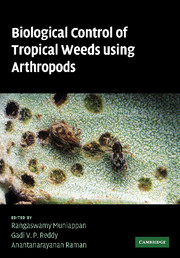Book contents
- Frontmatter
- Contents
- List of contributors
- Acknowledgments
- 1 Biological control of weeds in the tropics and sustainability
- 2 Acacia nilotica ssp. indica (L.) Willd. ex Del. (Mimosaceae)
- 3 Australian Acacia species (Mimosaceae) in South Africa
- 4 Ageratina adenophora (Sprengel) King and Robinson (Asteraceae)
- 5 Azolla filiculoides Lamarck (Azollaceae)
- 6 Cabomba caroliniana Gray (Cabombaceae)
- 7 Invasive cactus species (Cactaceae)
- 8 Chromolaena odorata (L.) King and Robinson (Asteraceae)
- 9 Clidemia hirta (L.) D. Don (Melastomataceae)
- 10 Coccinia grandis (L.) Voigt (Cucurbitaceae)
- 11 Eichhornia crassipes (Mart.) Solms–Laub. (Pontederiaceae)
- 12 Lantana camara Linn. (Verbenaceae)
- 13 Mimosa diplotricha C. Wright ex Sauvalle (Mimosaceae)
- 14 Mimosa pigra L. (Leguminosae)
- 15 Parthenium hysterophorus L. (Asteraceae)
- 16 Passiflora mollissima (HBK) Bailey (Passifloraceae)
- 17 Pistia stratiotes L. (Araceae)
- 18 Prosopis species (Leguminosae)
- 19 Salvinia molesta D. S. Mitchell (Salviniaceae)
- 20 Solanum mauritianum Scopoli (Solanaceae)
- 21 Application of natural antagonists including arthropods to resist weedy Striga (Oranbanchaceae) in tropical agroecosystems
- 22 Biological control of weeds in India
- 23 The role of International Institute of Tropical Agriculture in biological control of weeds
- 24 The role of Secretariat of the Pacific Community in the biological control of weeds in the Pacific Islands region – past, present, and future activities
- Index
12 - Lantana camara Linn. (Verbenaceae)
Published online by Cambridge University Press: 04 August 2010
- Frontmatter
- Contents
- List of contributors
- Acknowledgments
- 1 Biological control of weeds in the tropics and sustainability
- 2 Acacia nilotica ssp. indica (L.) Willd. ex Del. (Mimosaceae)
- 3 Australian Acacia species (Mimosaceae) in South Africa
- 4 Ageratina adenophora (Sprengel) King and Robinson (Asteraceae)
- 5 Azolla filiculoides Lamarck (Azollaceae)
- 6 Cabomba caroliniana Gray (Cabombaceae)
- 7 Invasive cactus species (Cactaceae)
- 8 Chromolaena odorata (L.) King and Robinson (Asteraceae)
- 9 Clidemia hirta (L.) D. Don (Melastomataceae)
- 10 Coccinia grandis (L.) Voigt (Cucurbitaceae)
- 11 Eichhornia crassipes (Mart.) Solms–Laub. (Pontederiaceae)
- 12 Lantana camara Linn. (Verbenaceae)
- 13 Mimosa diplotricha C. Wright ex Sauvalle (Mimosaceae)
- 14 Mimosa pigra L. (Leguminosae)
- 15 Parthenium hysterophorus L. (Asteraceae)
- 16 Passiflora mollissima (HBK) Bailey (Passifloraceae)
- 17 Pistia stratiotes L. (Araceae)
- 18 Prosopis species (Leguminosae)
- 19 Salvinia molesta D. S. Mitchell (Salviniaceae)
- 20 Solanum mauritianum Scopoli (Solanaceae)
- 21 Application of natural antagonists including arthropods to resist weedy Striga (Oranbanchaceae) in tropical agroecosystems
- 22 Biological control of weeds in India
- 23 The role of International Institute of Tropical Agriculture in biological control of weeds
- 24 The role of Secretariat of the Pacific Community in the biological control of weeds in the Pacific Islands region – past, present, and future activities
- Index
Summary
Introduction
Lantana camara Linn. (Verbenaceae) (lantana) is a pantropical weed, affecting pastures, orchards, and native forests in about 70 countries worldwide (Day et al., 2003b). Lantana camara (sensu lato) is a composite species and is thought to have originated from two or more lantana species from tropical America. Dutch explorers introduced the plant into the Netherlands in the 1600s from Brazil (Stirton, 1977). It was then hybridized in glasshouses in Europe prior to its introduction to other countries as an ornamental.
Lantana camara can grow as individual clumps or dense thickets, displacing desirable species. In disturbed natural forests, it can form the dominant understory, disrupting succession and decreasing biodiversity. Its allelopathic qualities can reduce vigor of plant species nearby and reduce productivity in orchards (Holm et al., 1991). Lantana camara outcompetes native pastures, interferes with the mustering of cattle, and causes death of stock by poisoning (Swarbrick et al., 1998). In Southeast Asia and the Pacific Island communities, it can reduce productivity in orchards and plantations and interferes with harvesting. It flowers prolifically and the seeds are dispersed by birds (Swarbrick et al., 1998). Lantana camara has several uses, mainly as herbal medicines and in some areas as firewood and mulch (Sharma et al., 1988; Sharma and Sharma, 1989). Lantana camara can be controlled through the use of chemicals, mechanical removal, fire, and planting of competitive species. However, in many situations these methods are not feasible.
- Type
- Chapter
- Information
- Biological Control of Tropical Weeds Using Arthropods , pp. 211 - 246Publisher: Cambridge University PressPrint publication year: 2009
- 11
- Cited by

